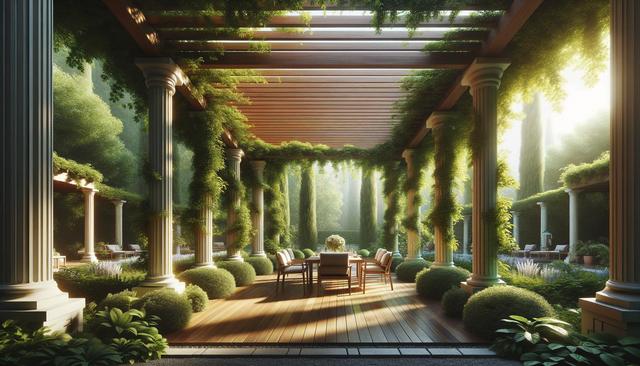What Are Pergolas?
Pergolas are outdoor structures typically made with vertical posts and crossbeams, providing partial shade while maintaining an open-air feel. They can be freestanding or attached to a building and are often used to define a specific area within a garden or backyard. While they do not offer complete protection from the elements like a fully enclosed patio cover, pergolas provide a comfortable space that blends seamlessly with the natural surroundings. The design of pergolas can vary widely, from simple wooden frames to more elaborate constructions incorporating metal or composite materials.
The versatility of pergolas makes them suitable for various outdoor settings. Many homeowners use them to create a dining area, a lounge space, or even a walkway accentuated with climbing plants. The open structure allows for airflow and natural light, making pergolas a pleasant addition to any landscape design. Their aesthetic appeal and functionality make them a popular choice for those looking to expand their outdoor living areas.
Benefits of Adding a Pergola to Your Property
Installing pergolas can bring several advantages beyond visual appeal. One of the primary benefits is the creation of a defined outdoor space for relaxation or entertainment. By adding furniture, lighting, or even curtains, a pergola can be transformed into a cozy retreat that enhances your lifestyle.
Some key benefits include:
- Enhanced outdoor living space
- Increased property value
- Support for climbing plants and greenery
- Customizable design options
- Partial shade and improved airflow
Additionally, pergolas can help demarcate functional areas in larger yards, making the space more organized and user-friendly. Whether you’re looking to host gatherings or simply enjoy a quiet evening outdoors, pergolas provide a structured yet open environment that accommodates both.
Material Choices and Design Options
When planning for pergolas, selecting the right material is crucial for both durability and appearance. Common materials include wood, metal, and vinyl, each offering distinct characteristics. Wooden pergolas are favored for their natural look and ease of customization. However, they require regular maintenance to prevent weather-related damage. Metal pergolas, typically made from aluminum or steel, offer robust construction and modern aesthetics, often requiring less maintenance. Vinyl pergolas are valued for their low upkeep and clean, contemporary style.
Design options are equally varied. You can opt for classic, rustic, modern, or minimalist styles depending on your landscape and personal taste. Additional features like built-in lighting, retractable canopies, or integrated seating can elevate the functionality of your pergola. The design can also be tailored to complement existing outdoor elements such as patios, pools, or gardens.
Installation Considerations
Before installing pergolas, several practical factors should be taken into account. Assessing the location is essential—consider sun patterns, wind exposure, and proximity to your home or other structures. A well-placed pergola should enhance the usability of your yard without obstructing natural views or pathways.
It’s also important to check local regulations and building codes. Depending on your area, a permit may be required for larger or attached pergolas. Hiring a professional can ensure that your pergola is both structurally sound and compliant with local laws. For DIY enthusiasts, prefabricated kits are available and can simplify the building process, though they may offer fewer customization options.
Budget is another key consideration. Costs can vary significantly based on size, materials, and added features. Planning ahead can help you allocate resources effectively and avoid unexpected expenses during the project.
Maintenance and Longevity
Maintaining pergolas is essential to preserving their appearance and structural integrity. Wood structures generally require the most upkeep, including sealing, staining, or painting to protect against moisture and insects. It’s advisable to inspect wooden pergolas annually for signs of wear or damage.
Metal and vinyl pergolas are generally easier to maintain. These materials resist weathering and can usually be cleaned with a mild detergent and water. However, occasional checks for rust (metal) or cracks (vinyl) are still recommended to ensure safety and longevity.
To further extend the lifespan of pergolas, consider these maintenance tips:
- Clean regularly to prevent mold or mildew buildup
- Prune climbing plants to avoid excess weight and damage
- Inspect joints and fasteners for stability
- Protect against pests, especially in wood structures
With proper care, pergolas can remain a beautiful and valuable feature of your outdoor space for many years.
Conclusion
Pergolas are a timeless addition to any outdoor setting, offering both style and function. Whether you’re interested in defining a garden area, creating a cozy seating nook, or enhancing property value, pergolas present a versatile solution. With thoughtful planning, the right materials, and regular maintenance, they can become a lasting feature of your home landscape. For homeowners seeking to enrich their outdoor experience, investing in a pergola is a practical and rewarding choice.








